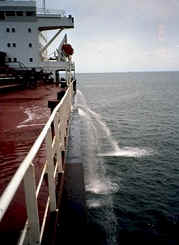GBA action on Ballast Water
 Ballast water is important for vessel safety and stability, but ever since invasive species started arriving in the ballast of lake freighters, GBA has been calling for tighter ballast regulations to protect the Great Lakes and Georgian Bay from the devastation that these invasive species can and have caused. GBA has pushed for tighter regulations to ensure the reduction/elimination of invasive species entering the Great Lakes and Georgian Bay via ballast water.
Ballast water is important for vessel safety and stability, but ever since invasive species started arriving in the ballast of lake freighters, GBA has been calling for tighter ballast regulations to protect the Great Lakes and Georgian Bay from the devastation that these invasive species can and have caused. GBA has pushed for tighter regulations to ensure the reduction/elimination of invasive species entering the Great Lakes and Georgian Bay via ballast water.
In 2020, the Canadian Government through Transport Canada put forward a new set of regulations to help combat the negative impacts of ballast water.
The new regulations put forward include:
- give effect to the Convention in Canada and address Canada’s international obligations, including the protection of foreign environments, by repealing the existing regulations and replacing them with the new proposed Ballast Water Regulations, which will apply to Canadian vessels everywhere and all vessels in waters under Canadian jurisdiction;
- Incorporate by reference the Convention’s requirements, which includes imposing requirements based on the vessel’s length, its ballast water capacity, its date of construction, and its area of operation;
- reduce the risk to Canada’s environment and economy associated with the introduction and spread of aquatic invasive species released through the ballast water of foreign and domestic vessels;
- maximize compatibility with the differing and evolving United States ballast water regime; and
- mitigate, to the extent feasible, technical uncertainty associated with the Convention, notably in the Great Lakes–St. Lawrence River region
In particular, vessels that operate internationally will be required to be in compliance with the Convention regime, which requires that vessels:
- have on board and implement an approved vessel-specific Ballast Water Management Plan;
- be surveyed and carry a Ballast Water Management Certificate;
- meet a performance standard that limits the number of organisms capable of reproducing in order to reduce the risk of aquatic species;
- record ballast water operations and maintain a Ballast Water Record Book on board;
- be subject to inspections in ports or offshore terminals to ensure compliance;
- flush otherwise empty ballast tanks with open ocean water in order to reduce the risk posed by any residual ballast water and sediments;
- exchange and flush ballast tanks in addition to meeting the performance standard when travelling to Canadian freshwater ports; and
- report on the provenance and management of ballast water discharged in Canada.
The full set of regulations can be found here
There have been concerns put forward from other organizations that these regulations may impact Canada and the US shipping industry and this is something the GBA is aware of and following.
For more information on this topic check our past GBA website posts and outside articles
- GBA post: Canadian Government Moves Forward on Ballast Water Regulations
- GBA post: Transport Canada Sets Timetable for New Ballast Water Regulation
- GBA post: Canadian Ballast Water Regulations
- GBA post: Algal Bloom-Causing Phytoplankton May Be Arriving in Ballast Water
- GBA post: Canada Gazette, Part I, Volume 153, Number 23: Ballast Water Regulations
- Newswire: Minister Garneau Proposes New Regulations on Ballast Water to Better Protect Against Aquatic Invasive Species
- Great Lakes Echo: Researchers want invasive aquatic critters out of Great Lakes ballast water
